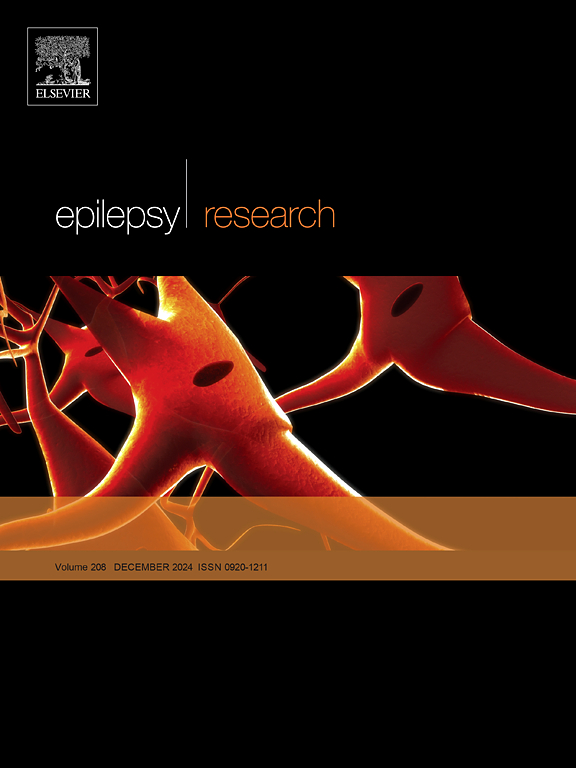Efficacy of transcutaneous vagus nerve stimulation (t-VNS) in treating drug-resistant epilepsy: A systematic review and meta-analysis
IF 2
4区 医学
Q3 CLINICAL NEUROLOGY
引用次数: 0
Abstract
Background
Epilepsy is a disease that affects over 50 million people globally. It poses significant challenges, especially for those with drug-resistant forms. This study aims to evaluate the efficacy of transcutaneous vagus nerve stimulation (t-VNS) in treating drug-resistant epilepsy by conducting a systematic review and meta-analysis.
Methods
We adhered to PRISMA guidelines and registered the study with PROSPERO. Randomized clinical trials (RCTs) focusing on t-VNS for patients aged 14 and above with drug-resistant epilepsy were included. PubMed, Elsevier, CENTRAL, and Web of Science databases were searched up to December 2023. Data extraction and risk of bias assessment were independently conducted by two reviewers, with discrepancies resolved by a third.
Results
Out of 2782 studies identified, four RCTs involving 417 subjects were included. The meta-analysis revealed that t-VNS significantly reduced seizure frequency at various time points, notably at 8, 12, 16, and 52 weeks. However, no significant difference in responder rates between the t-VNS and control groups was found. Quality of life improvements were observed in some studies, while adverse effects were generally mild and transient.
Conclusion
t-VNS has a favorable safety profile to reduce seizure frequency in drug-resistant epilepsy. Despite these positive findings, variations in study methodologies and a high risk of bias necessitate further high-quality research to confirm these results and better integrate t-VNS into clinical practice.
经皮迷走神经刺激(t-VNS)治疗耐药癫痫的疗效:系统回顾和荟萃分析
癫痫是一种影响全球5000多万人的疾病。它带来了重大挑战,特别是对那些具有耐药形式的人。本研究旨在通过系统综述和荟萃分析来评价经皮迷走神经刺激(t-VNS)治疗耐药癫痫的疗效。方法我们遵循PRISMA指南,并在PROSPERO注册研究。纳入了针对14岁及以上耐药癫痫患者的t-VNS的随机临床试验(rct)。检索截止到2023年12月的PubMed、Elsevier、CENTRAL和Web of Science数据库。数据提取和偏倚风险评估由两位审稿人独立进行,差异由第三位审稿人解决。结果在2782项研究中,纳入了4项随机对照试验,涉及417名受试者。荟萃分析显示,t-VNS在不同时间点显著降低癫痫发作频率,特别是在8、12、16和52周。然而,t-VNS组和对照组的应答率没有显著差异。在一些研究中观察到生活质量的改善,而不良反应通常是轻微和短暂的。结论vns在降低耐药癫痫发作频率方面具有良好的安全性。尽管有这些积极的发现,但研究方法的差异和高偏倚风险需要进一步的高质量研究来证实这些结果,并更好地将t-VNS纳入临床实践。
本文章由计算机程序翻译,如有差异,请以英文原文为准。
求助全文
约1分钟内获得全文
求助全文
来源期刊

Epilepsy Research
医学-临床神经学
CiteScore
0.10
自引率
4.50%
发文量
143
审稿时长
62 days
期刊介绍:
Epilepsy Research provides for publication of high quality articles in both basic and clinical epilepsy research, with a special emphasis on translational research that ultimately relates to epilepsy as a human condition. The journal is intended to provide a forum for reporting the best and most rigorous epilepsy research from all disciplines ranging from biophysics and molecular biology to epidemiological and psychosocial research. As such the journal will publish original papers relevant to epilepsy from any scientific discipline and also studies of a multidisciplinary nature. Clinical and experimental research papers adopting fresh conceptual approaches to the study of epilepsy and its treatment are encouraged. The overriding criteria for publication are novelty, significant clinical or experimental relevance, and interest to a multidisciplinary audience in the broad arena of epilepsy. Review articles focused on any topic of epilepsy research will also be considered, but only if they present an exceptionally clear synthesis of current knowledge and future directions of a research area, based on a critical assessment of the available data or on hypotheses that are likely to stimulate more critical thinking and further advances in an area of epilepsy research.
 求助内容:
求助内容: 应助结果提醒方式:
应助结果提醒方式:


